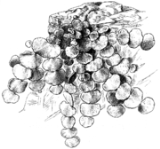
Halimeda
Encyclopedia

Calcium carbonate
Calcium carbonate is a chemical compound with the formula CaCO3. It is a common substance found in rocks in all parts of the world, and is the main component of shells of marine organisms, snails, coal balls, pearls, and eggshells. Calcium carbonate is the active ingredient in agricultural lime,...
is deposited in its tissues, making it inedible to most herbivore
Herbivore
Herbivores are organisms that are anatomically and physiologically adapted to eat plant-based foods. Herbivory is a form of consumption in which an organism principally eats autotrophs such as plants, algae and photosynthesizing bacteria. More generally, organisms that feed on autotrophs in...
s.
As in other members of the order Bryopsidales
Bryopsidales
Bryopsidales is an order of green algae, in the class Bryopsidophyceae.-Characteristics:The thallus is filamentous and much branched and may be packed into a mass. It is coenocytic, having multi-nucleate cells consisting of cytoplasm contained within a cylindrical cell wall...
, individual organisms are made up of single multi-nucleate cells. Whole meadows may consist of a single individual alga connected by fine threads running through the substrate.
Halimeda is responsible for distinctive circular deposits in various parts of the Great Barrier Reef
Great Barrier Reef
The Great Barrier Reef is the world'slargest reef system composed of over 2,900 individual reefs and 900 islands stretching for over 2,600 kilometres over an area of approximately...
on the north-east coast of Queensland, Australia
Australia
Australia , officially the Commonwealth of Australia, is a country in the Southern Hemisphere comprising the mainland of the Australian continent, the island of Tasmania, and numerous smaller islands in the Indian and Pacific Oceans. It is the world's sixth-largest country by total area...
. Halimeda beds form in the western or lee side of outer shield reefs where flow of nutient-rich water from the open sea allows them to flourish, and are the most extensive, actively accumulating Halimeda beds in the world.
The genus is one of the best studied examples of cryptic species pairs due to morphological convergence within the marine macroalgae.



Species

- H. bikinensis
- H. borneensis
- H. cereidesmis
- H. copiosa
- H. cryptica
- H. cuneata
- H. cylindracea
- H. discoidea
- H. distorta
- H. favulosa
- H. fragilis
- H. gigas
- H. goreauii
- H. gracilis
- H. heteromorpha
- H. howensis
- H. hummii
- H. incrassata
- H. kanaloana
- H. lacrimosa
- H. lacunalis
- H. macroloba
- H. macrophysa
- H. magnidisca
- H. melanesica
- H. micronesica
- H. minima
- H. monile
- H. opuntia
- H. pumila
- H. pygmaea
- H. renschii
- H. scabra
- H. simulans
- H. stuposa
- H. taenicola
- H. tunaHalimeda tunaHalimeda tuna is a species of green macroalgae.Halimeda tuna is the type species of the genus Halimeda....
- H. velasquezii
External links
- Australian Institute of Marine ScienceAustralian Institute of Marine ScienceThe Australian Institute of Marine Science is a state-of-the-art tropical marine research centre located primarily at Cape Ferguson, 50km by road east of Townsville in North Queensland, Australia. It was established in 1972, by the Commonwealth of Australia...
, retrieved 10 November 2006 - "Other species of conservation concern",
- Great Barrier Reef Marine Park Authority, retrieved 10 November 2006

